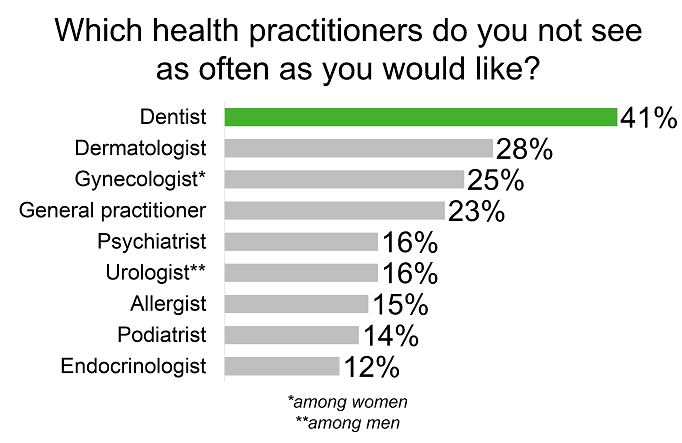Dentists top the list of health practitioners Americans want to see more of
Survey finds over 40% of U.S. adults say they don't go to the dentist as often as they'd like compared to other health practitioners
OAK BROOK, Illinois - January 4, 2017 - Americans want to see their dentists more often. A survey, out today from Delta Dental, finds that dentists lead the pack of health practitioners adults want to see more.
According to the survey, 41 percent of American adults reported they do not get to the dentist as often as they'd like, coming out 13 percent higher than the next health practitioner, dermatologists at 28 percent.
The full rankings of health practitioners Americans wish they visited more often, from the 2016 Adult Oral Health Survey:

Adults who give their oral health an "A" grade are 24 percent less likely to put the dentist at the top of the list of practitioners they want to see more. Those who brush their teeth less than twice a day want to go more than those who brush at least twice a day (52 percent vs. 28 percent).
"Seeing the dentist regularly is an important part of maintaining good oral health," said Bill Kohn, DDS, Delta Dental Plans Association's vice president of dental science and policy. "We're at least glad to see that even those who aren't getting to the dentist as often as they'd like, recognize the importance of making more time to do so."
Good oral health can lead to a boost in confidence and overall well-being, according to the survey.
- 79 percent of American adults agree there is a connection between oral health and overall health.
- Adults who are extremely satisfied with their oral health rate their overall well-being as very good (48 percent), compared to those who report they are not satisfied (28 percent).
- 63 percent feel that good oral health helps them feel confident on a daily basis, more so than having clear skin (56 percent) or being in shape (50 percent).
About the Survey: The Adult Oral Health Survey was conducted between December 16, 2015 and January 14, 2016 among a nationally representative sample of 1,025 Americans 18+. The margin of error is +/- 3.1 percent.
